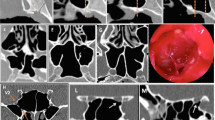Abstract
Purpose
Endoscopic endonasal transsphenoidal surgery (EETS) requires abundant collaborative work between neurosurgeon and ear, nose, and throat (ENT) surgeon. In low-volume centers, however, the surgery may be carried out completely and solely by a neurosurgeon. The current study evaluates the differences in both technique and complications in the approach to the sphenoid sinus for endoscopic endonasal approach (EEA) performed solely by a single neurosurgeon compared to collaborative effort between neurosurgery and otolaryngology.
Methods
The study comprises 50 consecutive patients with intra-sellar pituitary lesions undergoing EETS. Half of the patients were operated completely by single neurosurgeon (group A) and the other half by collaboration between single ENT surgeon, as a primary surgeon during nasal step, and the neurosurgeon (group B). Both groups were assessed intra-operatively as to operative technique, average time of EEA to sphenoid sinus, and presence of endonasal structural difficulties and complications.
Results
A significant difference was recorded between both groups regarding average time of EEA to sphenoid sinus (P < 0.001) and incidence of intraoperative nasal complications (P = 0.006). There was a difference between ENT surgeon and neurosurgeon adopting the same approach to sphenoid sinus. Sphenoid sinus approaches from group B characterized by their short duration (mean 10 vs 22 min) and low incidence of intraoperative endonasal complications (4.8% vs 28%).
Conclusion
Study results emphasized the necessity of collaboration between neurosurgeon and ENT surgeon in endoscopic endonasal approaches, to efficiently deal with intraoperative endonasal difficulties and complications which pose difference for both surgeons performing the same surgical procedure.


Similar content being viewed by others

References
Jankowski R, Auque J, Simon C, Marchal JC, Hepner H, Wayoff M (1992) How i do it: head and neck and plastic surgery: endoscopic pituitary tumor surgery. Laryngoscope 102(2):198–202
Jho H-D, Carrau RL (1997) Endoscopic endonasal transsphenoidal surgery: experience with 50 patients. J Neurosurg 87(1):44–51
Stammberger H (1986) Endoscopic endonasal surgery—concepts in treatment of recurring rhinosinusitis. Part II. Surgical technique. Otolaryngol Head Neck Surg 94(2):147–156
Har-El G (2007) Surgical approaches to the sphenoid sinus. In: Kountakis SE, Önerci M (eds) Rhinologic and sleep apnea surgical techniques. Springer, Berlin, Heidelberg, pp 73–81
Singh A, Wessell AP, Anand VK, Schwartz TH (2011) Surgical anatomy and physiology for the skull base surgeon. Op Tech Otolaryngol Head Neck Surg 22(3):184–193
van Lindert EJ, Ingels K, Mylanus E, Grotenhuis JA (2010) Variations of endonasal anatomy: relevance for the endoscopic endonasal transsphenoidal approach. Acta Neurochir 152(6):1015–1020
D’Haens J, Van Rompaey K, Stadnik T, Haentjens P, Poppe K, Velkeniers B (2009) Fully endoscopic transsphenoidal surgery for functioning pituitary adenomas: a retrospective comparison with traditional transsphenoidal microsurgery in the same institution. Surg Neurol 72(4):336–340
Prevedello DM, Kassam AB, Gardner PA, Carrau RL, Snyderman CH (2010) Expanded endoscopic endonasal approaches to the skull base. In: Cappabianca P, Iaconetta G, Califano L (eds) Cranial, craniofacial and skull base surgery. Springer, Milano, pp 239–251
Doglietto F, Prevedello DM, Jane JA Jr, Han J, Laws ER Jr (2005) A brief history of endoscopic transsphenoidal surgery-from Philipp Bozzini to the First World Congress of Endoscopic Skull Base Surgery. Neurosurg Focus 19(6):1–6
Gandhi CD, Christiano LD, Eloy JA, Prestigiacomo CJ, Post KD (2009) The historical evolution of transsphenoidal surgery: facilitation by technological advances. Neurosurg Focus 27(3):E8
Sethi DS, Pillay PK (1995) Endoscopic management of lesions of the sella turcica. J Laryngol Otol 109(10):956–962
Jho H-D, Carrau R (1996) Endoscopy assisted transsphenoidal surgery for pituitary adenoma. Acta Neurochir 138(12):1416–1425
Bolger WE, Parsons DS, Butzin CA (1991) Paranasal sinus bony anatomic variations and mucosal abnormalities: CT analysis for endoscopic sinus surgery. Laryngoscope 101(1):56–64
Zinreich J (1993) Imaging of inflammatory sinus disease. Otolaryngol Clin N Am 26(4):535–547
Gupta T, Aggarwal A, Sahni D (2013) Anatomical landmarks for locating the sphenoid ostium during endoscopic endonasal approach: a cadaveric study. Surg Radiol Anat 35(2):137–142
Dusick JR, Esposito F, Mattozo CA, Chaloner C, McArthur DL, Kelly DF (2006) Endonasal transsphenoidal surgery: the patient’s perspective—survey results from 259 patients. Surg Neurol 65(4):332–341
Tataranu L, Gorgan M, Ciubotaru V, Dricu A, Dediu A, Ene B et al (2010) Endoscopic endonasal transsphenoidal approach in the management of sellar and parasellar lesions: alternative surgical techniques, results, complications (Part II). Rom Neurosurg 17:182–191
Funding
All authors declare that they did not receive any source of funding for this study.
Author information
Authors and Affiliations
Corresponding author
Ethics declarations
Conflict of interest
All authors declare that they have no conflict of interest.
Ethical approval
All procedures performed in studies involving human participants were in accordance with the ethical standards of the institutional and national research committee and with the 1964 Helsinki declaration and its later amendments.
Informed consent
Informed consent was obtained from all individual participants included in the study.
Rights and permissions
About this article
Cite this article
Ismail, M., Abdelaziz, A.A. & Darwish, M. A comparison between collaborative and single surgeon approach in endoscopic endonasal surgery to sphenoid sinus. Eur Arch Otorhinolaryngol 276, 1095–1100 (2019). https://doi.org/10.1007/s00405-019-05305-y
Received:
Accepted:
Published:
Issue Date:
DOI: https://doi.org/10.1007/s00405-019-05305-y



